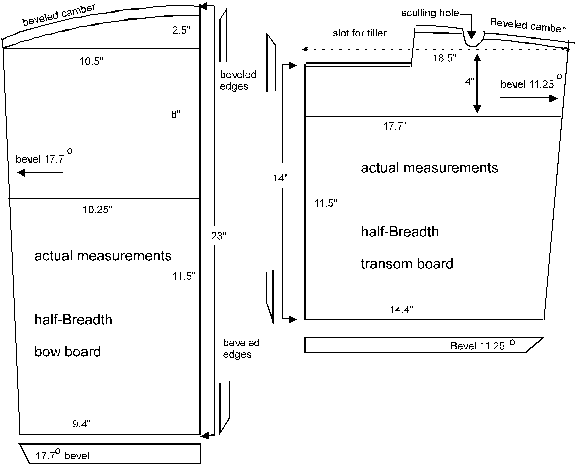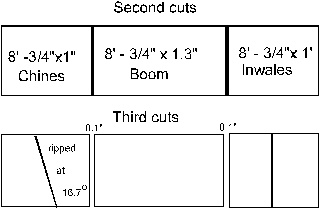| CHAPTER 2 PARTS
LAYOUT
Special
Saw Blade
A special, smooth-cutting, thin, multi-tooth,
table-saw blade for plywood cost C$15.
It costs probably less in the USA.
It will rip and crosscut softwood lumber up to ¾" thick
without difficulty. The cut
is only 1/10" (0.1") wide.
Use this blade also for the sawing of the parts of the two 10'
– 1x12s, and for the thinner battens of the two 8' – 2x4s.
Actual
Measurements of the Bow and Transom Boards

Layout of the two 10' - 1x12s
Bow and
Transom Boards
The parts for these boards are cut from a 1x12 as
is shown in the drawings above. Exploit
the bevels of the sides of the boards to gain extra length.
The actual height (length)
of the board is 23" (3" for the crown, 8.5"
for the top isosceles trapezoid, and 11.5" for the bottom
isosceles trapezoid).
Build up the bow board
from two pieces of 1x12 that are glued together over the narrow edge.
The constant bevel of the side edges is 17.7º.
The top plank of the bow board has a crown that is 2.5"
high on the centreline. The
(adjusted) base of the crown at sheer line height is 2 x 10.5" =
21" wide. The bottom edge of that isosceles trapezoid plank is 20.5"
wide. The height of the
trapezoid is 8.5"
The top edge of the bottom plank is also 20.5"
wide. The bottom edge of
this isosceles trapezoid is 18.8"wide.
Make a template of the full-sized board on of Bristol board.
With this template, double-check these measurement after
the sides are placed on the (temporary) cross frames before cutting
the parts from the 1x12s! The
layout allows for small adjustments, an/or corrections.
The crown and the bottom edges of the bow board have a sharp,
acute, constant bevel. For
accuracy, measure, and cut the bevels after a “dry run” of
the board on the jig.
The bottom part of the
transom board is cut from the same 1x12 as the bow board.
The top part is cut from the second 1x12.
The actual length of the
transom board is 17" (1.5" for the crown, 4"
for the top isosceles trapezoid, and 11.5"for the bottom
part). The constant
bevel of the sides of the board is 11.25º.
At the base of the crown the width of the board is 37".
At the bottom edge, the transom board measures 28.8".
In the middle, at the two glued-together narrow edges, the board
measures 35.4".
Again, make a template of Bristol board.
With the template, double-check these measurements after
the sides are placed on the cross frames, and before cutting the
parts.
Both board are cambered and beveled at the
top. The drawings show that
the high side of the bevels is on the outside.
How to construct a camber line is shown in the Appendix.
The bevels of the crown at the sheers, and the bottom edge are
measured when the boards are (temporary) attached to the sides in a
trial run. They are made in
line with the sheer and the bottom lines.
First
10' - 1x12
The drawing shows how to cut the first 10' –
1x12.

Wait with cutting this plank until their exact
measurements are verified on the jig with the Bristol board template.
Second 10' – 1x12

First, with the special saw blade, rip off the 1"-wide
batten over the whole length of the plank.
Split this batten at flare angle (16.7º) into the two
guardrail slats. Tape them
together; store them where they can’t break.
From the 10.4"-wide plank, cut the top part of the
transom board, and the amidships’ thwart.
The top side of the amidships thwart is flush with the top edge
of the dagger board box. The dagger board box is anchored in the thwart as is shown in
the set of plans on page 7. The
end sides of the thwart are beveled at flare angle.
The top part of the transom board produces a 3"-wide
leftover for the tiller. The
skeg, the rudderpost, the triangular bow deck support, the two plates
for the mast foot block, the tiller extension, and the supports for the
transom bench are cut from the last 42.8" of the plank.
The exact measurements of these parts are taken directly from the
upturned hull.
Layout of the two 8' - 2x4s
The actual dimensions of a 2x4 are 1½"x
3½". Each 2x4 is
ripped into two planks. The
cuts are 1/8" wide.
First
2x4
Rip the first 2x4 into one plank of the standard
thickness of ¾"x3½".
Then, with the special plywood blade, rip the 8' – ¾"x
3½" plank into 3 battens:
Two of 8' - ¾"x1" After deducting for two cuts
of 1/10", the third batten measures 8' – ¾"x1.3".

With the special,
multi-tooth blade for plywood, rip the first 8' – 3/4"x1"
at flare angle (16.7º). These
two beveled slats are the inside chines.
Rip he second batten of 8'
- ¾"x1" at the same angle (16.7º). These two slats, the inwales, are attached on the
inside of the hull between bow deck and mast thwart, and between mast
thwart and transom board after the hull is taken of the jig and
the thwarts are placed.
The third batten (8' - ¾"x1.3")
forms the main part for the boom of the lugsail.

After deducting 1/8"
for the cut, the second plank measures 8' - 5/8"x3½".
With the special, multi-tooth blade for plywood, rip the
eight-feet plank into exactly six thin slats of 8' -
5/8"x1/2".
(6 x 1/2" + 5 x
1/10" = 3"+ 1/2" = 3½").
Use three of the six 8-ft.slats for the keelson, and one
for the keel. Cut
one slat into two pieces of 4'.
They are the sliders to protect the bottom.
They are attached to the bottom parallel to the keel at 11"
distance on each side of the keel amidships.
Use the last 8' - 5/8"x1/2" to strengthen the
boom.
Second
2x4
Rip the second 2x4 into two halves of exactly the
same thickness. The result
is two planks of (1½" - 1/8") / 2 = (12/8" –
1/8") / 2 = 11/16" thickness.
The actual measurements of each plank are: 8' - 11/16"x3½".
With the special blade for
plywood, cut each of the planks into three parts.
Glued together at the small edges, each set of three parts forms
a 3 x 3½" = 10½" wide board.
One 11/16"x10½" board becomes a bow deck.
The end edges are cut all with the same bevel setting of 16.7º
of the (constant) flare angle. Exploit
the bevel angles in the cutting. Cut, and place each piece separately
after verifying their exact length and bevel in the upturned
hull.
The second board of 11/16"x10½"
is used as a bench aft, 1½" fore of the transom.
Placed approximately one inch above the bottom, it gives a dry
seat aft. Lay in the
individual thwart pieces one by one just as it is done for the bow deck.
Again, exploit the bevel angles in the cutting.
Cut, and place each piece separately after verifying
their exact length and bevel in the upturned hull.
Cutting the
Plywood
All plywood
parts are cut with the 10", 200-tooth, special blade for cutting
plywood. In addition,
tape all to-be-cut lines with masking tape to reduce splintering.

The four leftover pieces from the bottom panel are
glued together with the two largest parts in the middle. With their long, common straight side, they are glued and
screwed fore to the bow board as an ornamental bow piece.
BUILDING JIG, TEMPORARY
CROSS FRAMES
Full-Sized
Jig, Cross Frames’ Bevel Angles
Construct the full-sized jig from two 10' -
2x3s set on their narrow (1½") side 17" apart
on three pieces of scrap plywood measuring 20"x15". For easy dismantling of the jig, use screws to put the ladder
together.

The four triangular longitudinal frames, ¼"
thick at least, are set on top of the plywood against the insides of
the 2x3s. The ¼"
cross frames fore and aft are held plumb with screws into each pair of
longitudinal frames. See
the drawings above.
The measurements of the cross frames are adjusted
to the inside of the hull.
The cross frame fore
is placed fore of, and against the station line BBaC.
The distance between that station line BBaC and station Beam is 56".
The bevel angle of the sides of this frame at station BBaC is 18º.
The ¼" cross
frame at Beam, (station #8) is set against and aft of that
station line.
The cross frame aft
is set aft of, and against the station line #11 (station
line TBaC). The distance of
this station line (#11) and station Beam (station #8) is 36".
The adjusted distance between the frames on the jig
is 36" – ¼" = 35.75".
The bevel angle of the sides of the cross frames at stations #5,
and #11, is 11.5º.
“Third”
Hand Extension
The lower part of the cross frames are extended
approximately 2"on each side as shown in the drawings on the
next pages. Place the side
panels on these extensions. Hold
the side panels against the cross frames with binder clamps.
Even clothespins will work.
Make sure that the sides can be moved easily for adjustment.
The “third” hand eliminates the need of a helper.
It allows you to interrupt the work on the project at any time.
Cross Frame Adjustments on the Jig.
Cut the panels for the cross frames approximately 1"
higher than needed. The
excess is removed after a “dry-run” with the side panels on
the rig. That way, it
becomes easy to cut the exact bevel for the rocker line of the bottom
into the frames at the same time.
Cross Frame at Beam (Station #8)
Draw the temporary cross
frame at station #8 (Beam) on a 2'x4' panel of ¼" plywood.
Since the cross frames will be discarded, use the cheapest
available quality of plywood.
The
dimensions of the triangular brackets that hold the frames plumb on the
ladder are clearly shown in the jig drawing on page 13.

Cross Frames
at station #5 and TBaC (Station # 11)
Cross
Frame at BBaC (Station #3 + 4")
The cross frame is drawn on a 21"x30"panel
of plywood. The two
triangular frames are placed against it on top of the first ladder rung
on the inside of the 2x3s as shown on page 13.
The frame must be adjusted flush with the beveled edge fore on
cross frame BbaC.
See the drawing on the next page.
Longitudinal
Frames
The frames secure the cross frames plump on the
ladder. The frames fore and
aft also hold the bow and transom board temporarily in place until these
boards are attached to the side panels.
The frames are set against the inside of 2x3s of the jig, on top
of the rungs. Their (adjusted) measurements are shown in the drawings at
the bottom of this page.



|
![]()